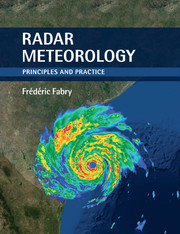Book contents
- Frontmatter
- Dedication
- Contents
- Preface
- Notation
- 1 Meteorology and radar
- 2 Fundamentals of weather radar measurements
- 3 Radar reflectivity and products
- 4 Reflectivity patterns
- 5 Doppler velocity information
- 6 The added value of dual polarization
- 7 Convective storm surveillance
- 8 Monitoring widespread systems
- 9 Radar estimation of precipitation
- 10 Nowcasting
- 11 Additional radar measurements and retrievals
- 12 Cloud and spaceborne radars
- 13 What does radar really measure?
- Appendix A Mathematics and statistics of radar meteorology
- References
- Index
9 - Radar estimation of precipitation
Published online by Cambridge University Press: 05 June 2015
- Frontmatter
- Dedication
- Contents
- Preface
- Notation
- 1 Meteorology and radar
- 2 Fundamentals of weather radar measurements
- 3 Radar reflectivity and products
- 4 Reflectivity patterns
- 5 Doppler velocity information
- 6 The added value of dual polarization
- 7 Convective storm surveillance
- 8 Monitoring widespread systems
- 9 Radar estimation of precipitation
- 10 Nowcasting
- 11 Additional radar measurements and retrievals
- 12 Cloud and spaceborne radars
- 13 What does radar really measure?
- Appendix A Mathematics and statistics of radar meteorology
- References
- Index
Summary
“It may be possible therefore to determine with useful accuracy the intensity of rainfall at a point quite distant (say 100 km) by the radar echo from that point.” With that sentence, Marshall et al. (1947) launched the quest for the hydrological use of radar. And despite tremendous progress, this quest still continues. As you might have appreciated, radar is a superb tool for measuring the spatial patterns of reflectivity at the altitude where the measurement is taken, which, with some uncertainties, can be assumed to be a spatially distributed estimate of instantaneous precipitation rate. However, what is needed for hydrological purposes is a precise measurement of precipitation accumulation at the surface over a relevant time period. This is what rain gauges measure best: gauges are poor instantaneous rain rate instruments, but their measurement error diminishes rapidly with integration time. As will be explained in this chapter, this is not the case for radars. The art of radar hydrology hence consists in transforming a time sequence of instantaneous estimates of reflectivity and of dual-polarization parameters aloft into an unbiased estimate of precipitation accumulation at the surface. Properly integrating precipitation rates in time to obtain accurate accumulations requires a systematic fight against every source of error that can build up in time. These include systematic fractional differences for every measurement, or bias errors, such as a 15% underestimation due to a 1 dB radar calibration error. An equally problematic and less obvious challenge comes from errors that have long correlation times and distances, meaning that they are variable in time and/or space, but the time constant of their variation is slow compared with the accumulation time of interest. An example of such an error would be the one associated with extrapolating measurements made aloft at 1 km to the surface: climatologically, the difference between rainfall aloft and at the surface may be zero, but on any given day, there could be net evaporation or net low-level growth depending on low-level moisture availability.
- Type
- Chapter
- Information
- Radar MeteorologyPrinciples and Practice, pp. 148 - 165Publisher: Cambridge University PressPrint publication year: 2015



